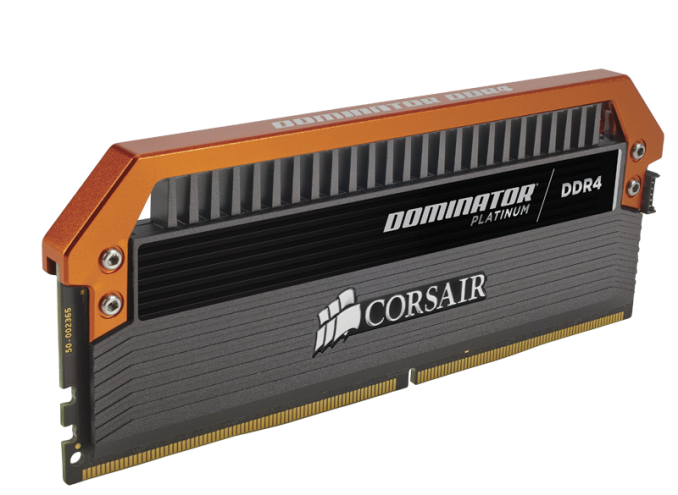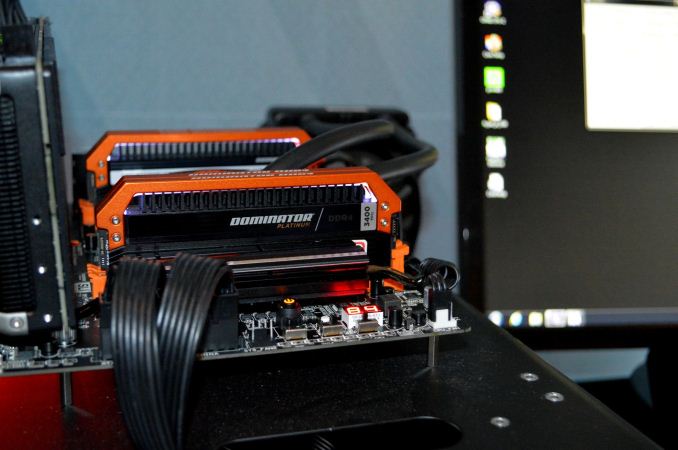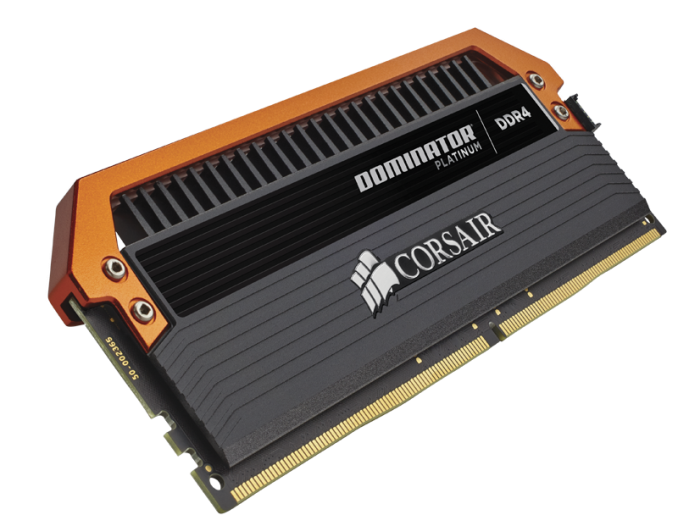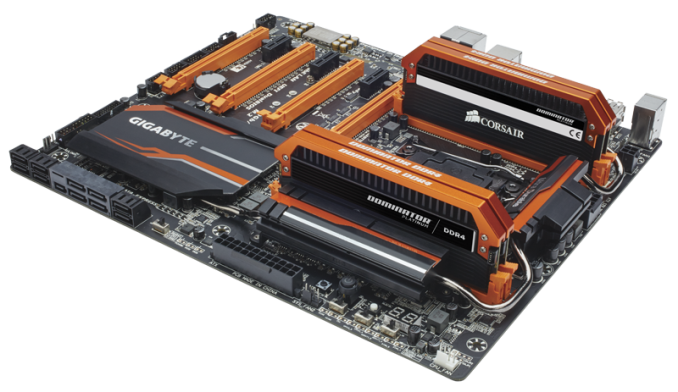Corsair Releases Orange Dominator Platinum DDR4-3400 for GIGABYTE X99-SOC Champion
by Ian Cutress on March 23, 2015 9:00 AM EST
During CES earlier this year we spent some time at the Corsair booth and saw a beta system demoing an orange kit of DDR4-3400 modules on the X99-SOC Champion. It would seem that now those modules are finally coming to market, with the X99-SOC Champion being the lead platform due to the styling. Both Corsair and GIGABYTE are pushing both the speed of the modules (at 16-18-18 sub-timings) and the motherboard which is designed to take care of the faster speeds.
We were the first to review the X99-SOC Champion when it was released at CES, and agreed that it had the chance to take the place for X99 overclockers on a budget. However, these DDR4-3400 modules will not come cheap with an MSRP of $999.99 for a 4x4GB kit, but will come with a lifetime warranty. Users of the X99-SOC Champion will have to update to BIOS F4d, which should be available online shortly, in order to enable XMP appropriately.
We actually have these modules in to test already, and applying XMP in our test system put the CPU into the 167 MHz strap at 160 MHz, resulting in a 22x multiplier on the CPU in order to keep the CPU frequency relatively consistent.
The reason it goes for this strap is because at the 100 MHz strap it would require a higher DRAM multiplier which may not be possible. In actual fact, our testing CPU would not allow the 100 MHz with a 34x DRAM multiplier, but neither would it allow 160 Mhz on the 167 MHz strap either due to a mediocre processor.
We were able to get the kit running at DDR4-3400 using the 125 MHz strap with a small overclock, which kind of confuses comparisons because it means the CPU is lower/higher in frequency, depending on the CPU multiplier (127.5 x 27 = 3440 MHz / 127.5 x 28 = 3570 MHz). One of the benefits of these high end memory kits with a processor at XMP will be that they require a CPU overclock to work properly, promoting performance (albeit indirectly). We tuned the CPU to stock speeds which reduced the kit to DDR4-3333 (still 16-18-18), and the biggest jumps from our quick testing showed WinRAR on Windows and Redis on Linux both getting improvements over 2133 MHz, similar to our deep dive into DDR4 performance.
We’ll roll out a full review, with new GPU benchmarks as well, at a later date. I would imagine that in time these modules will also be validated on other systems, however it would seem that GIGABYTE and Corsair have done a deal to focus on the X99-SOC Champion first. The modules will initially be available from corsair.com.















21 Comments
View All Comments
Gunbuster - Monday, March 23, 2015 - link
I dig the orange but $1000 for maybe 7% more performance? Nope.semyon95 - Monday, March 23, 2015 - link
More like 0,7% morenathanddrews - Monday, March 23, 2015 - link
Have these heat pipes/fins been proven to be useful in any way since the DDR/DDR2 era ended? I can't find much in the way of evidence to support the need for this beyond appearance. It seems like an obnoxious waste of space and material, like a 3-foot tall spoiler on a Honda Civic (different strokes...). You can still make aesthetically pleasing modules with low-profile RAM without adding cost with extra aluminum and copper. You can always add cooling options if you need it, but it's very difficult (often impossible) to remove the fins and pipes.It would be nice to have more options in that area.
The Von Matrices - Tuesday, March 24, 2015 - link
These memory heatsinks are actually the opposite in principle of those huge 3-foot spoilers. The huge spoilers, while ugly, are functional because they actually provide some downforce on the car. These memory modules are more like the 2-inch spoilers you see on "sports" cars - they look nice but they're designed without aerodynamic function in mind and are too small to have any real effect. If you made these memory module heatsinks obnoxiously large akin to the 3 foot spoiler, then you might see some improved performance, but then they also would not fit under a CPU heatsink, which is a consideration more important to most buyers.nathanddrews - Tuesday, March 24, 2015 - link
Perhaps I should have clarified - Honda Civics that are not modified, all-wheel-drive, 600hp hillclimbers. The only function those 3-foot spoilers offer on normal, everyday Civics is downforce on the back to "help" lift the front tires (steering/power) off the pavement. It's idiotic. :-PSn3akr - Monday, March 23, 2015 - link
They look good, but the pricing is ridiculous on the Corsair dominator Platinum.. Regardless of the speed.. They just don't offer performance to justify the higher costs. All u pay for is the looks. Kingston have lifetime warranty on most of their RAM but their not charging 1000$ for themDanNeely - Monday, March 23, 2015 - link
Absolute top speed DIMMs are always insanely priced; and probably always will be. You're looking at 1 chip in a thousand level binning, so there can only ever be a tiny number of them on the market total. Since that's the case, the only way to constrict demand down until it's as limited as the supply is to set prices high enough that the only people who buy them are money is no object suckers and competitive overclockers who need 1:1000 binned parts to have a shot at the top of the leaderboard.Halo products like this are seen as important for marketing purposes by the manufacturers, so they'll always be around. Fortunately for the rest of us, 1:10 binned chips aren't that much more expensive than the commodity chips that go into dells/etc and can give us a good OC without breaking the bank.
RaistlinZ - Monday, March 23, 2015 - link
They're still a complete waste of money. Anandtech's own review show PC2666 CL15 giving equal if not better performance in most cases.http://www.anandtech.com/show/8959/ddr4-haswell-e-...
DanNeely - Monday, March 23, 2015 - link
Good luck setting a record for the highest stable DDR4 clock rate, or any synthetic benchmark with a strong ram throughput dependency with a set of low end DIMMs. Otherwise, I called the people buying crazy expensive ram suckers for a reason.OTOH there are some workloads that do benefit from high performance ram. I don't have the URL handy, but a few weeks ago I came across some test results for the Einstien@Home distributed computing project (grav wave search app) that showed a 3770k @ 4.1 ghz getting a 10% reduction in task runtime from an upgrade from DDR3-1950 to DDR3-2400. It's possible that that behavior will change in the future (the app is being re-written in the hope of getting an OpenCL version to work on GPUs); but the codebase used since at least 2006 is notorious for putting the ram subsystem under heavy strain from randomish IO.
Antronman - Monday, March 23, 2015 - link
It's been known for a long time that Samsung ICs were the best, bar none for DDR3 overclocking. They could pull the tightest timings at the highest speeds. Every long standing DDR3 record ever set was done with Samsung ICs. Cheap, cheap 1x2GB Samsung ICs. Put EK Dominator heatspreaders on so you can put on a RAM pot. And you have world record potential.According to a few known users on the RoG users in the forums, it looks like Hynix (or was it Micron?) ICs are the best of the DDR4 batch.
4x4GBs is not OCing RAM. Too much strain on the memory controller. This is just a fancy kit for people who want to show off.